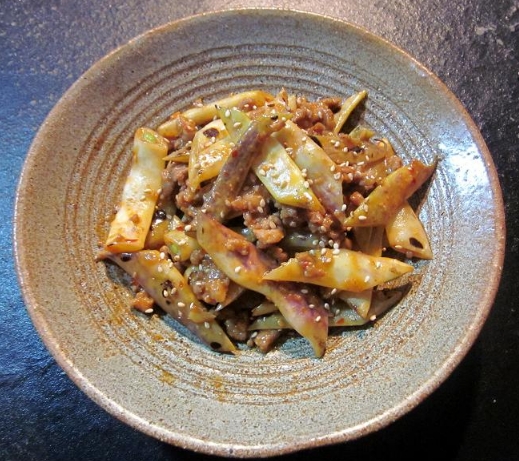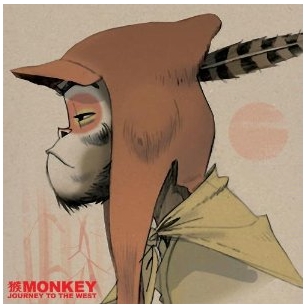It’s a glorious surprise when you walk through the garden in late August and find a huge bush full of beans when you thought you’d damn near killed them all. I completely forgot about them and never watered them enough! There’s no way… but, yes! There, standing tall and proud in a plastic tote full of chocolaty pudding-like soil, swaying gently in the fennel-scented breeze is a bush sagging under the weight of twenty Dragon’s Tongue beans! Thank you West Coast Seeds and thank the garden Gods!
Look at these crazy gorgeous beans!
So named for their distinctive bright purple veins, this Dutch heirloom variety is one tough little legume. Going from lime green to yellow during maturation on the vine, they only bust out the red dragon pattern when they’re ready to pick, which explains why I walked by so many times without spotting ’em. They’re a string-less snap bean, so you can eat them right away (pod’s and all) or just cut ’em in half and steam, saute, or whatever without any fuss.
In an attempt to preserve the supernaturally awesome “Dragon’s Tongue” pattern during cooking, I’ve opted to use the Chinese cooking technique of “dry-frying”. As the name suggests, it involves very little oil, and apocalyptic heat brought to bear quickly and definitively. With a white-hot searing and a little luck, my beautiful beans will be just tender enough to eat and still bright and colourful enough to enjoy looking at.
The recipe is a riff on a classic Szechuan-style face-melter that my wife and I enjoy frequently at the awesome Beijing House Restaurant in Campbell River, BC. Traditionally green beans or Chinese yard-long beans are used, but the poet inside me digs the symbolism of a dragon’s tongue spitting a fiery sauce of ground pork and Doubanjiang, a Chinese fermented soy and chilli paste.
Wait, what? You can take vegetables and cover them with a sauce made of pork? It sounded a bit crazy to me the first time, being accustomed to the European culinary tradition of meat being the prima donna of the plate while veg and sauces sing chorus. But this ‘aint Die Walküre, it’s more like Journey To The West… Different stage, different rules.
Dragon’s Tongue Beans with Spicy Pork Sauce
(Serves 2)
Ingredients
- 150g (5 ¼ oz.) Pork Tenderloin (cleaned of silverskin)
- Salt ‘n Pepper
- 10g (about 2 tsp.) Corn Starch
- 1 Large Garlic Clove (20g, peeled and minced)
- 1 Small Thumb ‘o Ginger (15g, peeled and minced)
- 30g (about 2 tbls.) Spicy Doubanjiang
- 10ml (about 2 tsp.) Dark Soy Sauce
- 16ml (1/2 an oz.) Chinese Sweet Cooking Wine or Japanese Mirin
- 120ml (1/2 cup) Chicken Stock
- 300g (10 ½ oz.) Dragon’s Tongue Beans (about 25, cleaned and ends trimmed, cut into 1” pieces)
Method
(A couple things about cooking Chinese food… First, you’re going to need a lot of heat to sear these ingredients properly and that means a lot of smoke, so you might want to crack the windows or fire up the exhaust fan in your kitchen. Second, the actual cooking process takes less than five minutes if you have properly laid out your ingredients in easily-reachable little bowls. It’s all about heat ‘n speed!)
- Mince Pork, place in a small bowl and season with salt and pepper. Mix cornstarch into the pork and let sit for 10 minutes.
- Mix the garlic and ginger together in a small bowl and set aside.
- Pour the doubanjiang, soy sauce, wine, and chicken stock into a medium-sized bowl and whisk until smooth. Set aside.
(Now that you’ve assembled all your cooking components it’s time to fire up your Wok! What…? You haven’t got a wok? Well I suppose you could use a frying pan or… You know what? No. Just go buy a steel or cast iron wok. They are available nearly everywhere and as long as they are relatively good quality, they’ll last a lifetime. Every kitchen should have one.)
- Put your wok on maximum heat and wait for it to begin to smoke slightly along the bottom. Reduce the heat just slightly from nuclear to sub-nuclear. Pour in 1 tablespoon of Sesame Oil and carefully swirl it along the inside of the wok, within seconds it should start to slightly smoke. Drop the seasoned Pork into the wok and immediately use a metal spatula to move it around and chop it up. The pork will begin to brown in about a minute and a half. The sizzle and spit will be aggressive, but don’t be afraid. Just keep that pork moving around the wok, tossing it and chopping it up as you go, and nothing will burn!
(Whenever I’m stir-frying anything I pretend I’m Chen Kenichi from the original Japanese Iron Chef show! Fwoooosh! Tamp Tamp Tamp! Woosh woosh! Tamp Tamp Tamp! Trust me, it helps.)
Once the pork is slightly browned, add the garlic and ginger and continue stir-frying for another 1 ½ minutes . At this point the whole kitchen will become beautifully fragrant.
- Reduce the heat to medium and pour in the doubanjiang sauce mixture. Swirl it around with your spatula and bring it up to a simmer. The liquid will thicken into a sauce all by itself in about a minute’s time. Remove your beautiful pork sauce from the heat and empty it into a waiting bowl for the time being.
- Wipe out the Wok with water and a damp cloth, don’t use soap, it ruins the Wok’s cooking surface. Dry it thoroughly and pour 1 teaspoon of sesame oil into the bottom. Using a piece of paper towel wipe the inside of the Wok, evenly coating the whole thing in a very thin layer of oil.
- Return the wok to maximum heat and once you start to see smoke along the bottom, toss in the beans. Dry-fry them for about 2 minutes, constantly moving and flipping them with your spatula. They will begin to char slightly along their edges, but that’s okay. Reduce heat to medium and pour in the pork sauce. Bring the wok up to a simmer, mixing your pork and beans together into a lovely shimmering stew-like consistency and you’re done! Garnish with toasted sesame seeds and serve with steamed white rice.


You have given detailed information and sufficient direction to enable a novice in oriental cuisine like me to actually think I could try such a recipe. I will share this recipe with my Chinese student Lee and maybe we will have a go at it. We don\t have access to the beans that you describe (that I know of) but maybe we could substitute another kind. I am a little insecure when it comes to very hot woks and the accompanying smoke but it could be exciting at best. This will be my first attempt with your suggested recipes. We will let you know how it goes.
Any green beans will work great! Chinese yard-Long beans are sold in some supermarkets and are another traditional bean for frying. Good luck with the Wok! Remember, if it all gets a bit nuts for you… Just remove the Wok from the heat, set it down, breathe, and fire it back up when you’re ready.
Big love.
The spicy bean paste is also sometimes spelled “Toban Djan” depending on the company that produces it.